Daniele Malitesta
ContextGNN goes to Elliot: Towards Benchmarking Relational Deep Learning for Static Link Prediction (aka Personalized Item Recommendation)
Mar 20, 2025

Abstract:Relational deep learning (RDL) settles among the most exciting advances in machine learning for relational databases, leveraging the representational power of message passing graph neural networks (GNNs) to derive useful knowledge and run predicting tasks on tables connected through primary-to-foreign key links. The RDL paradigm has been successfully applied to recommendation lately, through its most recent representative deep learning architecture namely, ContextGNN. While acknowledging ContextGNN's improved performance on real-world recommendation datasets and tasks, preliminary tests for the more traditional static link prediction task (aka personalized item recommendation) on the popular Amazon Book dataset have demonstrated how ContextGNN has still room for improvement compared to other state-of-the-art GNN-based recommender systems. To this end, with this paper, we integrate ContextGNN within Elliot, a popular framework for reproducibility and benchmarking analyses, counting around 50 state-of-the-art recommendation models from the literature to date. On such basis, we run preliminary experiments on three standard recommendation datasets and against six state-of-the-art GNN-based recommender systems, confirming similar trends to those observed by the authors in their original paper. The code is publicly available on GitHub: https://github.com/danielemalitesta/Rel-DeepLearning-RecSys.
DataRec: A Framework for Standardizing Recommendation Data Processing and Analysis
Oct 30, 2024



Abstract:Thanks to the great interest posed by researchers and companies, recommendation systems became a cornerstone of machine learning applications. However, concerns have arisen recently about the need for reproducibility, making it challenging to identify suitable pipelines. Several frameworks have been proposed to improve reproducibility, covering the entire process from data reading to performance evaluation. Despite this effort, these solutions often overlook the role of data management, do not promote interoperability, and neglect data analysis despite its well-known impact on recommender performance. To address these gaps, we propose DataRec, which facilitates using and manipulating recommendation datasets. DataRec supports reading and writing in various formats, offers filtering and splitting techniques, and enables data distribution analysis using well-known metrics. It encourages a unified approach to data manipulation by allowing data export in formats compatible with several recommendation frameworks.
Ducho meets Elliot: Large-scale Benchmarks for Multimodal Recommendation
Sep 24, 2024



Abstract:In specific domains like fashion, music, and movie recommendation, the multi-faceted features characterizing products and services may influence each customer on online selling platforms differently, paving the way to novel multimodal recommendation models that can learn from such multimodal content. According to the literature, the common multimodal recommendation pipeline involves (i) extracting multimodal features, (ii) refining their high-level representations to suit the recommendation task, (iii) optionally fusing all multimodal features, and (iv) predicting the user-item score. While great effort has been put into designing optimal solutions for (ii-iv), to the best of our knowledge, very little attention has been devoted to exploring procedures for (i). In this respect, the existing literature outlines the large availability of multimodal datasets and the ever-growing number of large models accounting for multimodal-aware tasks, but (at the same time) an unjustified adoption of limited standardized solutions. This motivates us to explore more extensive techniques for the (i) stage of the pipeline. To this end, this paper settles as the first attempt to offer a large-scale benchmarking for multimodal recommender systems, with a specific focus on multimodal extractors. Specifically, we take advantage of two popular and recent frameworks for multimodal feature extraction and reproducibility in recommendation, Ducho and Elliot, to offer a unified and ready-to-use experimental environment able to run extensive benchmarking analyses leveraging novel multimodal feature extractors. Results, largely validated under different hyper-parameter settings for the chosen extractors, provide important insights on how to train and tune the next generation of multimodal recommendation algorithms.
Dot Product is All You Need: Bridging the Gap Between Item Recommendation and Link Prediction
Sep 11, 2024


Abstract:Item recommendation (the task of predicting if a user may interact with new items from the catalogue in a recommendation system) and link prediction (the task of identifying missing links in a knowledge graph) have long been regarded as distinct problems. In this work, we show that the item recommendation problem can be seen as an instance of the link prediction problem, where entities in the graph represent users and items, and the task consists of predicting missing instances of the relation type <<interactsWith>>. In a preliminary attempt to demonstrate the assumption, we decide to test three popular factorisation-based link prediction models on the item recommendation task, showing that their predictive accuracy is competitive with ten state-of-the-art recommendation models. The purpose is to show how the former may be seamlessly and effectively applied to the recommendation task without any specific modification to their architectures. Finally, while beginning to unveil the key reasons behind the recommendation performance of the selected link prediction models, we explore different settings for their hyper-parameter values, paving the way for future directions.
How Fair is Your Diffusion Recommender Model?
Sep 06, 2024



Abstract:Diffusion-based recommender systems have recently proven to outperform traditional generative recommendation approaches, such as variational autoencoders and generative adversarial networks. Nevertheless, the machine learning literature has raised several concerns regarding the possibility that diffusion models, while learning the distribution of data samples, may inadvertently carry information bias and lead to unfair outcomes. In light of this aspect, and considering the relevance that fairness has held in recommendations over the last few decades, we conduct one of the first fairness investigations in the literature on DiffRec, a pioneer approach in diffusion-based recommendation. First, we propose an experimental setting involving DiffRec (and its variant L-DiffRec) along with nine state-of-the-art recommendation models, two popular recommendation datasets from the fairness-aware literature, and six metrics accounting for accuracy and consumer/provider fairness. Then, we perform a twofold analysis, one assessing models' performance under accuracy and recommendation fairness separately, and the other identifying if and to what extent such metrics can strike a performance trade-off. Experimental results from both studies confirm the initial unfairness warnings but pave the way for how to address them in future research directions.
A Novel Evaluation Perspective on GNNs-based Recommender Systems through the Topology of the User-Item Graph
Aug 21, 2024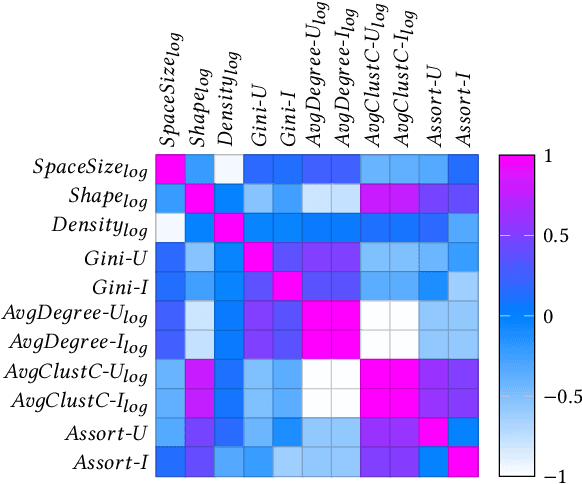
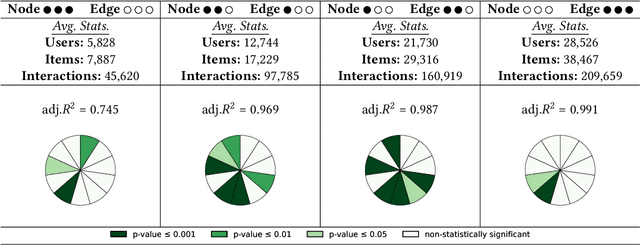
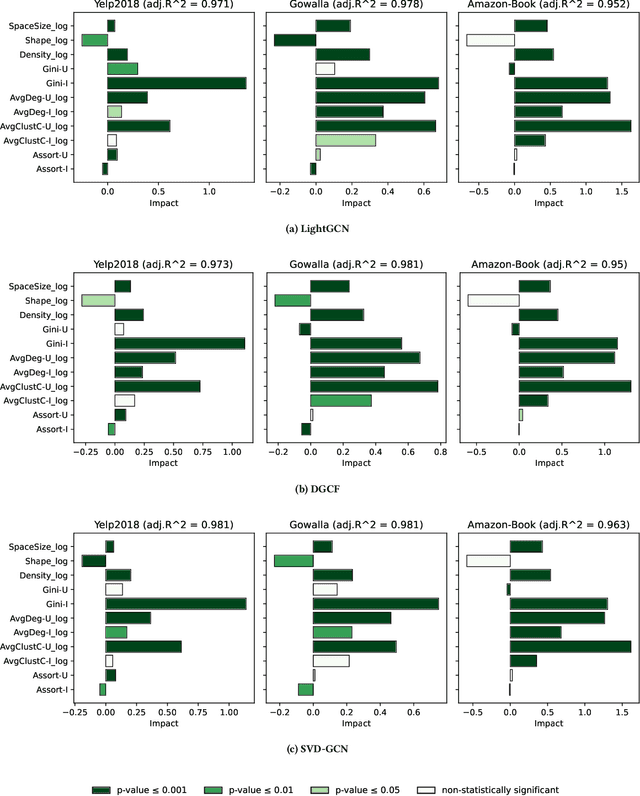
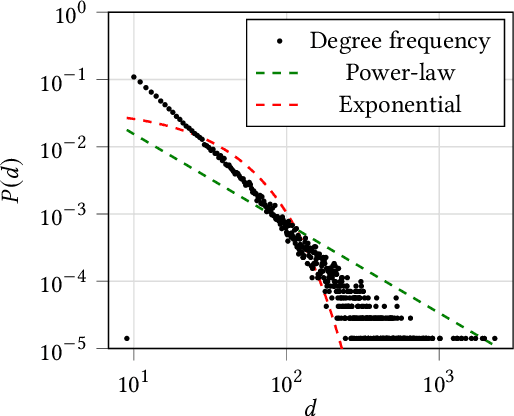
Abstract:Recently, graph neural networks (GNNs)-based recommender systems have encountered great success in recommendation. As the number of GNNs approaches rises, some works have started questioning the theoretical and empirical reasons behind their superior performance. Nevertheless, this investigation still disregards that GNNs treat the recommendation data as a topological graph structure. Building on this assumption, in this work, we provide a novel evaluation perspective on GNNs-based recommendation, which investigates the impact of the graph topology on the recommendation performance. To this end, we select some (topological) properties of the recommendation data and three GNNs-based recommender systems (i.e., LightGCN, DGCF, and SVD-GCN). Then, starting from three popular recommendation datasets (i.e., Yelp2018, Gowalla, and Amazon-Book) we sample them to obtain 1,800 size-reduced datasets that still resemble the original ones but can encompass a wider range of topological structures. We use this procedure to build a large pool of samples for which data characteristics and recommendation performance of the selected GNNs models are measured. Through an explanatory framework, we find strong correspondences between graph topology and GNNs performance, offering a novel evaluation perspective on these models.
Do We Really Need to Drop Items with Missing Modalities in Multimodal Recommendation?
Aug 21, 2024
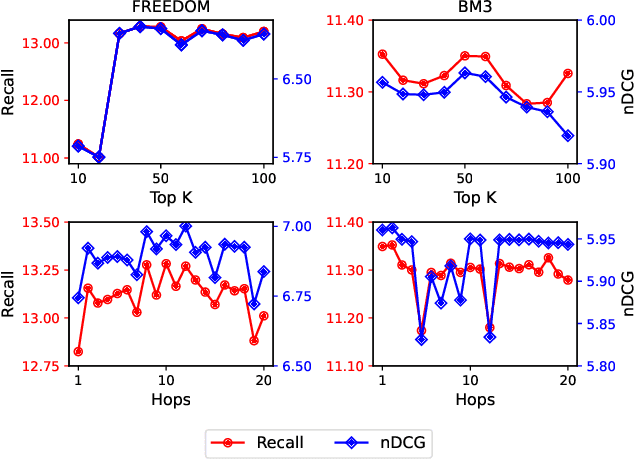

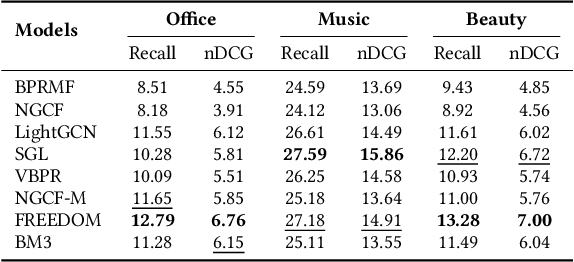
Abstract:Generally, items with missing modalities are dropped in multimodal recommendation. However, with this work, we question this procedure, highlighting that it would further damage the pipeline of any multimodal recommender system. First, we show that the lack of (some) modalities is, in fact, a widely-diffused phenomenon in multimodal recommendation. Second, we propose a pipeline that imputes missing multimodal features in recommendation by leveraging traditional imputation strategies in machine learning. Then, given the graph structure of the recommendation data, we also propose three more effective imputation solutions that leverage the item-item co-purchase graph and the multimodal similarities of co-interacted items. Our method can be plugged into any multimodal RSs in the literature working as an untrained pre-processing phase, showing (through extensive experiments) that any data pre-filtering is not only unnecessary but also harmful to the performance.
KGUF: Simple Knowledge-aware Graph-based Recommender with User-based Semantic Features Filtering
Mar 29, 2024



Abstract:The recent integration of Graph Neural Networks (GNNs) into recommendation has led to a novel family of Collaborative Filtering (CF) approaches, namely Graph Collaborative Filtering (GCF). Following the same GNNs wave, recommender systems exploiting Knowledge Graphs (KGs) have also been successfully empowered by the GCF rationale to combine the representational power of GNNs with the semantics conveyed by KGs, giving rise to Knowledge-aware Graph Collaborative Filtering (KGCF), which use KGs to mine hidden user intent. Nevertheless, empirical evidence suggests that computing and combining user-level intent might not always be necessary, as simpler approaches can yield comparable or superior results while keeping explicit semantic features. Under this perspective, user historical preferences become essential to refine the KG and retain the most discriminating features, thus leading to concise item representation. Driven by the assumptions above, we propose KGUF, a KGCF model that learns latent representations of semantic features in the KG to better define the item profile. By leveraging user profiles through decision trees, KGUF effectively retains only those features relevant to users. Results on three datasets justify KGUF's rationale, as our approach is able to reach performance comparable or superior to SOTA methods while maintaining a simpler formalization. Link to the repository: https://github.com/sisinflab/KGUF.
Dealing with Missing Modalities in Multimodal Recommendation: a Feature Propagation-based Approach
Mar 28, 2024Abstract:Multimodal recommender systems work by augmenting the representation of the products in the catalogue through multimodal features extracted from images, textual descriptions, or audio tracks characterising such products. Nevertheless, in real-world applications, only a limited percentage of products come with multimodal content to extract meaningful features from, making it hard to provide accurate recommendations. To the best of our knowledge, very few attention has been put into the problem of missing modalities in multimodal recommendation so far. To this end, our paper comes as a preliminary attempt to formalise and address such an issue. Inspired by the recent advances in graph representation learning, we propose to re-sketch the missing modalities problem as a problem of missing graph node features to apply the state-of-the-art feature propagation algorithm eventually. Technically, we first project the user-item graph into an item-item one based on co-interactions. Then, leveraging the multimodal similarities among co-interacted items, we apply a modified version of the feature propagation technique to impute the missing multimodal features. Adopted as a pre-processing stage for two recent multimodal recommender systems, our simple approach performs better than other shallower solutions on three popular datasets.
Graph Neural Networks for Treatment Effect Prediction
Mar 28, 2024



Abstract:Estimating causal effects in e-commerce tends to involve costly treatment assignments which can be impractical in large-scale settings. Leveraging machine learning to predict such treatment effects without actual intervention is a standard practice to diminish the risk. However, existing methods for treatment effect prediction tend to rely on training sets of substantial size, which are built from real experiments and are thus inherently risky to create. In this work we propose a graph neural network to diminish the required training set size, relying on graphs that are common in e-commerce data. Specifically, we view the problem as node regression with a restricted number of labeled instances, develop a two-model neural architecture akin to previous causal effect estimators, and test varying message-passing layers for encoding. Furthermore, as an extra step, we combine the model with an acquisition function to guide the creation of the training set in settings with extremely low experimental budget. The framework is flexible since each step can be used separately with other models or policies. The experiments on real large-scale networks indicate a clear advantage of our methodology over the state of the art, which in many cases performs close to random underlining the need for models that can generalize with limited labeled samples to reduce experimental risks.
 Add to Chrome
Add to Chrome Add to Firefox
Add to Firefox Add to Edge
Add to Edge